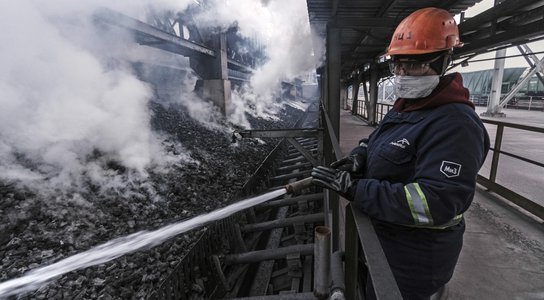Russian oil has been banned from the United States since April, and the EU and UK are set to follow suit. But while the US takes credit for attempting to cut off Russia’s fossil fuel trade, Americans are still filling their tanks with gasoline originating in Russia. How?

On March 8, before grim evidence of the massacres in Bucha, Irpin and Borodyanka emerged, President Joe Biden signed the first executive order addressing Russia’s war on Ukraine. E.O. 14066 established a ban on the import of Russian oil, coal, and liquefied natural gas. With it, the president said, “the American people will deal another powerful blow to Putin’s war machine”. The import ban was codified by Congress a month later.
The United States did end imports of those fossil fuels many months before the European and British bans on Russian crude oil are set to go into effect next year. And the ban has held: no one seems foolish enough to risk trying to sneak Russian oil into American ports.
As it turns out, though, no sanctions evasions are necessary. Once that oil has been refined into other products such as gasoline, the US officially doesn’t care if it came from Russian wells. An apparent loophole has allowed petroleum products originating in Russia to keep flowing to the US – a cycle that has kept funding the war on Ukraine.
Load, wash and rinse
Sanctions against Russia have so far failed to materially dent the fossil fuel trade funding its war on Ukraine. Even as Russian oil sales to Europe dropped by half a million barrels per day after the invasion, buyers in Asian markets made up the gap.
This has helped Russia earn record-high oil revenues since it invaded Ukraine – exactly the opposite of what Western sanctions were intended to solve.
But global petroleum markets move in sometimes unexpected ways. The US refines and exports petroleum products distilled from crude oil: gasoline and diesel, jet fuel and naphtha. It also imports these products from dozens of countries around the world. In June this year, tankers unloaded nearly 40 million barrels of refined petroleum at American ports, according to financial data provider Refinitiv.
India, Russia’s new star customer, is a net exporter of petroleum products, thanks to its refining power. The fourth largest refiner globally, after the US, China, and Russia, it has been especially swift to dial up imports of Russian crude. In its first fiscal quarter of 2022, the country imported about 682,000 barrels per day, compared with 22,500 barrels per day in the same period of 2021.
Much of this has been unloaded at Jamnagar port, in western India, a major refining hub. In June this year, more than a fifth of the port’s imports of crude and fuel oil came from Russia. The same month, India exported 2.7 million barrels of refined fuels to the United States on seven different ships. Five of those loaded in Jamnagar.
After crude oil is drilled out of the ground—in Western Siberia, perhaps, or an Arctic offshore oil field—it may travel by tanker, train, truck or pipeline to a refinery, where it is distilled into products like diesel and kerosene. Both incoming crude and finished products are stored in tanks throughout this process, which mixes petroleum products from different locations.
There is therefore no feasible way to tell where a particular gallon of gasoline came from originally. That means any shipment of fuels from a refinery using Russian oil may contain molecules from a Russian oil well.
This dynamic has been heavily scrutinized in recent weeks in Western media, portraying it as India undercutting Western countries’ sanctions by selling refined fuels made from Russian oil.
But that’s not the whole picture.
The EU has enacted six packages of sanctions against Russia, including measures aimed at kneecapping its oil and coal export trade. (Gas, which the EU relies on heavily, is so far a different story.) By 2023, most imports of Russian crude will be banned. For now, however, Russian oil imports to EU countries remain legal.
In June this year, just over 16 million barrels of Russian crude and fuel oil flowed into the Netherlands. The same month, the country exported just over four million barrels of diesel and gasoline to the United States: half as much again as India did. As with shipments from Jamnagar, fuel from Rotterdam may well have been made using Russian oil.
This transformation into a refined product appears to mean US sanctions no longer apply.
E.O. 14066 bans the import of fossil fuels “of Russian origin” and “products of their distillation”. But, the US Treasury wrote, this definition excludes “any Russian Federation origin good that has been incorporated or substantially transformed into a foreign-made product”. Refining crude oil into gasoline is considered a substantial transformation, in the language of customs offices.
With that sleight of hand, American imports of fuel originating from Russian oilfields are evidently washed of sanctions restrictions. Oil money can continue to flow to the Russian state, and so long as it does, Russia can continue to wage its war against Ukraine.
Breaking the cycle
This global laundering is why the first tier of sanctions that Western governments have imposed on Russia is not enough to end the war. There is no indication from the Treasury Department that the US is prepared to ban the import of fuels that have been made, or may have been made, from Russian oil. There is no feasible way to segregate those flows within the global petroleum system.
Global Witness is calling for the US to close this refining loophole by banning the import of any refined fuels that are made, or may have been made, with Russian crude. If President Biden’s executive order banning Russian oil is to be anything more than a PR exercise, this must apply to imports from all countries accepting and refining that crude. The UK and EU must follow suit.


